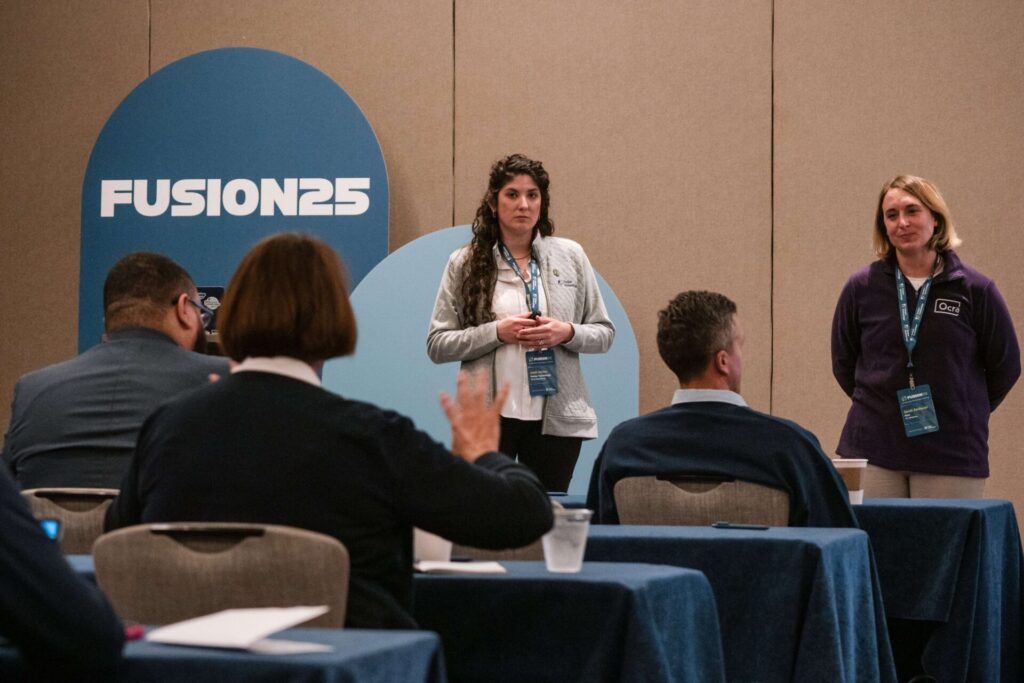
Customer experience doesn’t just happen. It’s designed – intentionally or not.
That’s why Sarah Becherer (VP of Marketing at Ocra) and Heidi Barber (VP of Marketing at Parker Technology) presented at FUSION25 on one of the most powerful (and underutilized) tools for improving customer experience: Customer Journey Mapping.
In their session, From Entry to Exit: Customer Journey Mapping, they showed how mapping customer interactions with your brand can reveal friction points, fix internal misalignments, and even boost ROI.
Here’s a recap of the session.
So…What Is a Customer Journey Map?
At its core, a customer journey map is a storyboard of your customer’s experience with your brand. Done right, it’s a diagnostic tool that reveals why customers love you, where they get frustrated, and what’s driving them to leave (or stay loyal).
Sarah described it best: “It’s the visual version of walking in your customer’s shoes, step by step.”
Unlike dashboards that focus purely on clicks, conversions or NPS, journey maps layer in three types of insight:
- Behavioral Data – What customers do
- Emotional Data – How they feel at every stage
- Operational Data – What’s happening internally to support them
This mix of human experience and analytics makes journey maps a secret weapon for marketers, operators and product teams alike. The best part? Every friction point you uncover turns into a tangible roadmap item for someone in your organization to address.
Or, as Sarah put it, “This is foundational work. Once you map it, you can turn those gaps into a real roadmap for your teams.”
Why It’s Worth the Effort
The stats speak for themselves:
- 24% more positive social mentions and 21% higher year-over-year retention
- 20-30% better internal alignment – because everyone finally knows who owns what
- 54% greater ROI on marketing spend
And if you need one more reason? Forrester reports that companies using journey maps reduce sales cycles by 18x and increase cross-sell/upsell revenue by 56%.
Heidi summed it up perfectly: “Handoffs kill. Mapping forces you to fix the gaps where things fall apart internally and for your customers.”
Who Are You Mapping For?
Here’s the mistake Sarah and Heidi see all the time: companies create one generic customer map and call it a day. But not all customers are the same, which is why personas matter.
A persona is a semi-fictional representation of a customer segment, built from interviews, behavioral data and conversations with real customers. The key is to move beyond surface-level demographics and ask the questions that reveal what truly drives their decisions.
Start with these:
- What is this customer trying to accomplish?
- What do they fear most? (Pain points often hide here.)
- What tools or workarounds are they currently using?
And sometimes, the insights are simple. One of Heidi’s favorite discoveries? Many parking operators still manage everything in Excel. That one detail alone reshaped how the Parker Technology marketing and product teams prioritized tech education around their solution.
Anatomy of a Journey Map
Once you know who you’re mapping for, you can build the actual journey. Sarah and Heidi broke it down into five components:
- Customer Persona(s): Who’s taking this journey? (Pick one to start!)
- Stages/Phases: What steps do they go through? For parking, that might look like:
- Search & Decision – How they find you
- Arrival & Entry – First impression at the entrance
- Park & Pay – Ease and reliability of transactions
- Exit – Smooth egress or frustrating backups
- Post-Visit Feedback – Would they recommend you? Will they come back?
- Emotional Audit: What are they feeling at each stage?
- Touchpoints & Channels: Where and how they interact with you (website, intercoms, kiosks, email or even the call center)
- KPIs, Pain Points & Gaps: What success looks like, and where the experience breaks
A great journey map should feel almost too detailed – emotions, metrics and internal owners all in one place. Why? Because the ultimate goal isn’t just to understand the journey, it’s to change it.
As Heidi reminded the audience: “A journey map that lives in a PowerPoint is worthless. The magic happens when you turn it into an action plan.”
Turning Maps into Action: A Real-World Example
Parker Technology and Ocra proved just how powerful this process can be.
Through journey mapping, they discovered that 10% of all customer service calls were reservation related.
The result? An API integration that gives Parker’s CSRs real-time reservation data at their fingertips. That means:
- Faster problem resolution
- Fewer frustrated customers
- Higher retention and repeat business
“This is exactly why we map,” Sarah explained. “You identify the pain point, then you fix it – with real tech, real processes and real results.”
Key Takeaways to Get Started
- Iterate. Journey maps are living documents – update them at least annually.
- Start small. Pick one persona, one route and build from there.
- Collaborate. Product, ops, sales and marketing all need to be in the room.
- Act quickly. Set a 30-day plan to tackle your top three gaps.
Heidi left the audience with this reminder: “Don’t let this become a one-and-done exercise. The magic only happens when you turn it into action.”
The Bottom Line
Customer journey mapping isn’t just a marketing exercise; it’s a company-wide strategy for building loyalty, improving efficiency and driving revenue.
If you’re looking for resources to get started, check out the Parketing Collective, a group of parking marketers that share tips, templates and real-world examples.
Want more insights from FUSION25? Stay tuned for more session recaps and stories from the people building excellence.
